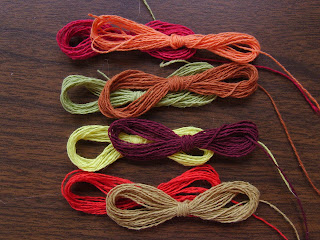The rug at right was woven on the Weaver's Delight. I decided not to unweave and fix the two sleying errors. I like how different the rugs can be with different colored warp and weave structure. The above rug was threaded in a twill, and the one on the right was plain weave, threaded in a log cabin rug pattern. I doubled the warp threads in the rust colored stripes, but the rest are threaded 12 epi.
I prepare for hemming my rugs in a couple different ways. When I finished weaving the rug on Fanny, I spread some Tacky Glue on the last 2-3 rows of weft, and let it dry. If you click on the photo, you can probably see it. After the glue is dry, I can cut the rug off without worrying about it unraveling. If I am going to immediately start weaving the next rug, I wouldn't use the glue, and would just weave a few extra rows of hem, to allow for unraveling.
I did that with the other rug, and then ran it through the serger to secure the last 2-3 weft rows.
I don't worry about the little bit of glue that gets folded into the hem. It is water soluble, so will eventually wash out.
I fold the second part of the hem so it partially covers the first fabric pick.
I don't use sewing pins. I have been poked too many times, so I switched to clothes pins. Avoid buying them from the dollar store, because the spring isn't strong enough. I found mine in my local grocery store.
Five clothes pins on each hem is plenty. I start my hem by closing up the end, turn and stitch the hem, then close the other end. It helps to stretch the hem while stitching. I don't use a home machine for the hems, because I own an industrial upholstery machine. If you have to use a home sewing machine, follow my tips to avoid breaking needles while sewing heavy fabric. It was published on my blog on 10-20-11.
I took a little time last night and this morning to fix the sleying errors, using one of my current favorite tools. It is a slick little sleying hook that I picked up this past spring while on my trip to go get my Weaver's Delight loom. The blade is super thin, but strong. I have caught myself with the hook a few times, when I wasn't being careful, and it can draw blood!
The reed hook is available from The Woolgatherers, in Wisconsin. I'm glad that Sara, the owner, suggested it.




















